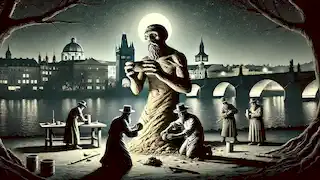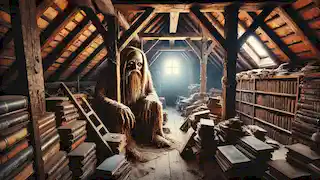The Legend of the Golem
Reading time: 11 min

About this story: The Legend of the Golem is a Legend from Czech Republic set in the Renaissance This Dramatic tale explores themes of Courage and is suitable for All Ages. It offers Cultural insights. The ancient protector of Prague rises again to defend the city.
In the heart of old Prague, in the labyrinthine alleys and cobblestone streets, there lies a tale shrouded in mystery and legend. It is the story of Rabbi Judah Loew ben Bezalel, the Maharal of Prague, and the creation of the Golem, an entity of clay brought to life to protect the Jewish community from persecution.
The Threat
The year was 1580. Prague was a bustling city filled with merchants, scholars, and artisans. Yet, beneath its vibrant surface, a dark undercurrent of anti-Semitism threatened the Jewish Quarter. Rumors of blood libel and imminent pogroms stirred fear among the Jews, who sought refuge in the wisdom and leadership of Rabbi Loew.
Rabbi Loew was a man of great intellect and spirituality, renowned for his deep understanding of Kabbalah. He spent countless nights in his study, poring over ancient texts and seeking divine guidance. One fateful night, as he meditated in his candlelit room, a vision came to him. It was a vision of a great protector, a Golem, fashioned from the very earth and endowed with supernatural strength.
Determined to bring this vision to life, Rabbi Loew gathered his most trusted disciples and shared his plan. They would create the Golem using sacred rituals and the Shem HaMephorash, the ineffable name of God. This Golem would serve as a guardian, defending the Jewish community from their enemies.
To prepare for this monumental task, Rabbi Loew and his disciples fasted and prayed for seven days. They purified themselves through ritual baths and donned white garments symbolizing purity and divine intention. Each night, they would gather in the synagogue, chanting psalms and reciting prayers, invoking the protection and guidance of the Almighty.
On the final night of their preparation, as the moon cast a silver glow over the city, Rabbi Loew received a sign from heaven. A brilliant star appeared in the sky, illuminating the path to the Vltava River. The time had come.

The Creation
Under the cover of darkness, Rabbi Loew and his disciples ventured to the banks of the Vltava River. There, in the silence of the night, they began their work. With meticulous care, they molded clay into the shape of a man, imbued with lifelike features. The clay figure was massive, towering over even the tallest of men.
As the final touches were made, Rabbi Loew inscribed the word "emet" (truth) on the Golem's forehead. Then, with a deep breath, he placed the Shem, a small piece of parchment bearing the name of God, into the Golem's mouth. In that moment, the Golem's eyes glowed with an otherworldly light, and it began to move.
The Golem stood before them, a silent sentinel, awaiting commands. Rabbi Loew named him Joseph and instructed him to protect the Jewish Quarter, to stand guard at night, and to assist in the synagogue during the day. The Golem's presence brought a sense of security and hope to the community, and tales of his strength and loyalty spread quickly.
Joseph was not only a protector but also a helper. During the day, he assisted with various tasks in the synagogue, moving heavy objects, and maintaining order. His strength was unmatched, and his silent dedication earned him the respect and admiration of the community. Children would often gather around him, their eyes wide with wonder, as he performed his duties with unwavering precision.
The Guardian
Joseph the Golem became a familiar figure in the Jewish Quarter. He patrolled the streets with unwavering vigilance, his heavy footsteps echoing through the night. Many would stop to watch him, marveling at the miracle wrought by Rabbi Loew's hands.
One evening, as the Golem made his rounds, he encountered a group of men plotting an attack on the synagogue. Without hesitation, Joseph intervened, his immense strength scattering the assailants like leaves in the wind. Word of the Golem's heroic deeds spread beyond the Jewish Quarter, reaching even the ears of Emperor Rudolf II.
The Emperor, intrigued by the stories, summoned Rabbi Loew to his court. He demanded to see the Golem, curious to witness the marvel for himself. Rabbi Loew, understanding the importance of maintaining a good relationship with the Emperor, agreed to the request.
When Joseph was brought before the Emperor, he stood silent and imposing, his presence filling the room with an aura of mystery and power. Emperor Rudolf, both awed and apprehensive, recognized the Golem's potential to keep the peace and protect his subjects. He granted Rabbi Loew and the Jewish community greater protection and privileges, ensuring their safety from further persecution.
Despite the newfound security, tension still simmered beneath the surface. Some members of the community feared the power of the Golem, whispering that he might one day turn against them. Others, including Rabbi Loew, knew that such power must be handled with great care and responsibility.
Rabbi Loew began to conduct regular rituals to ensure the Golem's obedience and to remind himself and his disciples of the divine origin of their creation. They would gather in the synagogue, reciting prayers and invoking blessings, reinforcing the spiritual bond that animated Joseph. The Golem, though silent and seemingly indifferent, would kneel before the altar, a symbol of his submission to the will of God.

The Fall
For many years, the Golem served faithfully, becoming a beloved protector and symbol of hope. However, as time passed, the very power that had created him became a source of unease. Some began to whisper that the Golem was too powerful, that he might one day turn against his creators.
Rabbi Loew, aware of these concerns and mindful of the delicate balance of power, decided that it was time to return the Golem to the earth from which he had come. It was a difficult decision, for the Golem had become like a son to him. Yet, he knew it was necessary to prevent any potential danger.
On a moonlit night, Rabbi Loew and his disciples led Joseph to the attic of the Altneuschul, the Old-New Synagogue. There, with a heavy heart, the Rabbi removed the Shem from the Golem's mouth and erased the word "emet" from his forehead, leaving only "met" (death). The Golem's eyes dimmed, and he became lifeless once more, a silent guardian waiting in repose.
The Golem's remains were hidden away, and Rabbi Loew vowed that they would only be reanimated in the direst of circumstances. The Jewish community, though saddened by the loss of their protector, understood the necessity of the Rabbi's actions and held on to the memory of the Golem's bravery and sacrifice.
In the weeks that followed, the Jewish Quarter returned to its normal rhythm, albeit with a lingering sense of loss. The streets seemed quieter without the heavy footsteps of Joseph, and the synagogue felt emptier without his silent presence. Yet, the people found solace in the knowledge that their protector was still with them, hidden but ready to rise again if needed.
Rabbi Loew continued his work, teaching and guiding his community with wisdom and compassion. He would often reflect on the lessons learned from the Golem, pondering the nature of power and responsibility. His writings from this period, rich with insights and reflections, would later become treasured texts, studied by scholars and mystics for generations.

The Legacy
Generations passed, and the story of the Golem became legend. Parents told their children of the mighty clay guardian who had once walked the streets of Prague, defending their ancestors from harm. The tale of Rabbi Loew and his creation was immortalized in countless books, plays, and artworks.
The attic of the Altneuschul remained a place of mystery and reverence. Some claimed to hear the faint sounds of the Golem's heavy footsteps at night, a reminder that he was still there, waiting for the moment when he might be needed again.
Prague itself seemed to carry the spirit of the Golem within its ancient walls and winding alleys. The city's rich history and mystical charm continued to draw visitors from around the world, all eager to uncover the secrets of its past.
Among the many who came to Prague seeking the truth behind the legend were scholars, historians, and mystics. They poured over ancient manuscripts and combed through the archives, piecing together the fragments of the Golem's story. Some sought to recreate the rituals that had given him life, while others hoped to understand the deeper spiritual truths embedded in the tale.
One such scholar was Dr. Samuel Klein, a professor of Jewish mysticism at the University of Prague. Dr. Klein had dedicated his life to studying the works of Rabbi Loew and the legend of the Golem. His office was filled with books, manuscripts, and artifacts, each telling a piece of the story he sought to unravel.
Dr. Klein's research led him to a discovery that would reignite interest in the Golem. Hidden in the margins of an old prayer book, he found a series of cryptic notes written by Rabbi Loew himself. These notes hinted at the possibility of reawakening the Golem, describing the conditions under which he might rise again.

The Return
In modern times, as new threats emerged, some began to wonder if the Golem would rise once more to protect the city. Scholars and historians studied Rabbi Loew's writings, hoping to unlock the secrets of his creation.
One day, a young scholar named Miriam, driven by
her fascination with the legend, discovered an ancient manuscript hidden in the depths of the library. It contained detailed instructions on how to bring the Golem to life, along with a plea from Rabbi Loew himself: "Let him rise only in the hour of utmost need."
With the city facing a new peril, Miriam felt the weight of her discovery. She gathered a group of like-minded individuals, and together, they decided to reawaken the Golem. In the attic of the Altneuschul, under the watchful eyes of history, they followed the ancient rituals, molding clay and inscribing the sacred words.
As the Shem was placed in the Golem's mouth once more, a familiar glow returned to his eyes. Joseph stood tall, ready to serve and protect. The legend of the Golem lived on, a timeless guardian ready to rise whenever Prague needed him most.
The city was abuzz with the news of the Golem's return. People flocked to the Jewish Quarter to catch a glimpse of the ancient protector. The atmosphere was electric with anticipation and hope, as the community once again felt the reassuring presence of Joseph.
As in the days of old, the Golem took up his duties with silent dedication. He patrolled the streets at night, his eyes glowing with an otherworldly light, and assisted in the synagogue during the day. His strength and vigilance brought a renewed sense of security to the city, and his story continued to inspire awe and wonder.

Epilogue: The Eternal Guardian
Years passed, and Prague thrived under the watchful gaze of the Golem. Yet, the lessons of his creation and reawakening were never forgotten. The story of Rabbi Loew and Joseph the Golem became a symbol of the enduring power of faith, wisdom, and the human spirit.
The Golem's legend continued to evolve, woven into the fabric of Prague's rich cultural heritage. Festivals and celebrations were held in his honor, and artists and writers found inspiration in his tale. The attic of the Altneuschul remained a place of pilgrimage, where people came to pay their respects and reflect on the timeless message of the Golem.
Dr. Samuel Klein, Miriam, and other scholars dedicated their lives to preserving and expanding the knowledge of Rabbi Loew's works. They formed a society, the Guardians of the Golem, committed to studying the ancient texts and ensuring that the wisdom of the past would guide the future.
In the end, the Golem's story is not just a tale of clay and magic but a testament to the enduring strength of community, the power of knowledge, and the unbreakable bond between protector and protected. As long as the city of Prague stands, so too will the legend of the Golem, a guardian for all time.

















